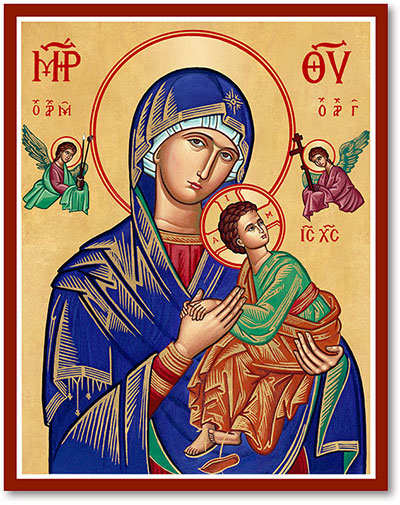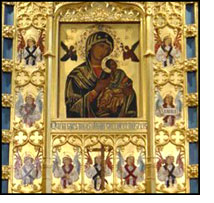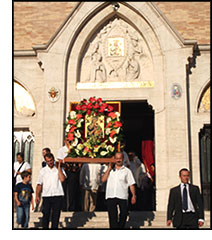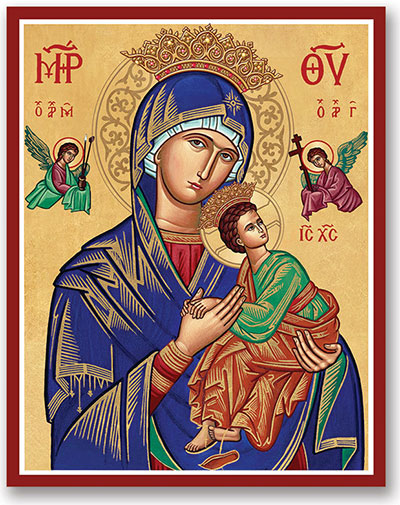The Story of the Most Famous Icon of the Virgin Mary
 The icon of Our Lady of Perpetual Help has inspired devotion for centuries, and is honored in hundreds of thousands of homes and churches throughout the world. When the original icon was brought to Saint Alphonsus Church in Rome in 1866, devotion to the Blessed Mother as depicted in this icon spread rapidly to Ireland, England, France, Spain, China, the USA, and the Philippines, largely through the missionary efforts of the Redemptorist Order.
The icon of Our Lady of Perpetual Help has inspired devotion for centuries, and is honored in hundreds of thousands of homes and churches throughout the world. When the original icon was brought to Saint Alphonsus Church in Rome in 1866, devotion to the Blessed Mother as depicted in this icon spread rapidly to Ireland, England, France, Spain, China, the USA, and the Philippines, largely through the missionary efforts of the Redemptorist Order.
Mother of Sorrows
The Holy Mother gazes at us with love and sorrow. The unimaginable grief she feels at the prospect of her Son's horrible death and suffering ("A sword shall pierce your heart," as the aged Simeon prophesied at Christ's presentation in the Temple) opens her heart to the pain of all humanity. And in her face we see an invitation for all of us to seek her compassionate help, her hands perpetually open to all who ask for it.
Many older versions of the icon carried an inscription reminiscent of the kontakia hymns of the Orthodox Church and in the first two lines references the Archangel Gabriel, who originally announced the advent of Christ to the Virgin:
He who first brought to the Most Pure Lady the news of joy
Now shows beforehand the signs of the Passion;
But Christ, clothed in mortal flesh and featuring death,
Is frightened at this vision.
Where did this icon come from? And who named it?
 Historians can only speculate about the origins of this icon. It reflects the style of the earliest Marian portraits, including icons attributed to Saint Luke the Evangelist, which was continued through the centuries by the Byzantine iconographers. The composition and style of the icon is classically Byzantine, with its stylized folds in the Virgin's and Christ's robes, the Greek abbreviations of "Jesus Christ" and "Mother of God," and the typically Byzantine-style angels.
Historians can only speculate about the origins of this icon. It reflects the style of the earliest Marian portraits, including icons attributed to Saint Luke the Evangelist, which was continued through the centuries by the Byzantine iconographers. The composition and style of the icon is classically Byzantine, with its stylized folds in the Virgin's and Christ's robes, the Greek abbreviations of "Jesus Christ" and "Mother of God," and the typically Byzantine-style angels.
Its first documented appearance is the record of its arrival at the Church of Saint Matthew in Rome in 1499. The parchment in the Vatican Library records that the icon was earlier located on the island of Crete, where the Holy Virgin worked many miracles through it.
A Cretan merchant stole the icon and fled to Rome. Soon he became deathly ill, and on his deathbed besought a Roman to give the icon to some place of worship where it could be venerated. But the Roman's wife convinced him to let her leave it in her bedroom. Several times the Virgin Mary appeared to the Roman to restore the icon to a more honorable place, but he ignored her. Finally she appeared to his six-year-old daughter, saying "Our Lady of Perpetual Help commands you to take her out of your house" – so our Lady herself gave the name by which we now know this icon. After two visitations like this, the mother gave this miraculous image to the Augustinian Fathers at the Church of Saint Matthew.
For the next three centuries the Church of Saint Matthew held its place as one of the most frequented pilgrimage sites in Rome, because Our Lady's icon was enshrined there. Pilgrims from all over the world, from lowly peasants to esteemed cardinals, flocked to see the miraculous icon and seek the Virgin's help and blessing.
Lost
On the black day of June 3, 1798 the French military governor of "Free Rome" (under Napoleon Bonaparte) commanded that thirty churches be destroyed. The Augustinians of Saint Matthew's packed up their most precious treasures, including Our Lady's icon, and fled into exile. The whereabouts of her icon were unknown to the faithful for decades, to be secretly venerated by the fathers who had taken refuge at the Church of St. Eusebio in Rome.
Looking
In the 1850's when a community of the Redemptorist Order (founded by Saint Alphonsus di Liguori) moved into new quarters near the ruins of the icon's former home of the Church of Saint Matthew, they heard about the wondrous history of the Church and its holy treasure. Beginning a search through documents and then through the city of Rome, which after almost fifteen years led them to the discovery of Our Lady's icon almost under their very noses, concealed in the Church of Saint Eusebio.
 Found and restored
Found and restored
On April 26, 1866 after a lengthy and glorious procession the icon of Our Lady of Perpetual Help was brought to the Church of Saint Alphonsus near her former home. Attended by thousands, many miraculous healings were reported.
The procession passed a house where a little boy of four lay dying. He had been given up as a hopeless case by the doctors. Hearing the singing, the child's grieving mother snatched him in her arms and hastened to the open window. Looking out at Our Lady's picture passing by she called out: "Dear blessed Mother, either cure my boy or take him to paradise!"
Our Lady chose the first, and the boy was cured at once. The next day he toddled along with his mother to St. Alphonsus' church and stood before the picture. He waved his little hands to the Madonna and cried "Grazie, grazie!"
As the procession was passing another house, another mother called upon Our Lady of Perpetual Help to aid her eight-year-old daughter who was completely paralyzed. At once the girl regained partial use of her limbs and was able to move about a bit. The next day the mother brought the child to St. Alphonsus' church to thank Our Lady and ask if she would not complete the cure. At once the child was restored to full health and vigor.
As to be expected, the report of those marvelous healings spread rapidly throughout the city and people came by the hundreds to visit the shrine. Soon the whole area around the altar was filled with abandoned crutches and canes and several whole glass-covered cabinets were filled with gold and silver thanksgiving offerings in the shapes of miniature hearts, arms, legs and other votive offerings.
 Crowned
Crowned
Many of us are familiar with the crowning of images of the Blessed Virgin that happens during the Marian month of May, in which to the accompaniment of hymns a statue of the Virgin is carried in procession and crowned with a floral wreath. This is known to have been a common custom as early as the 17th century, only celebrated then in a more formal and elevated manner. When devotion to a particular statue or icon was approved by the bishop of the area and a history of miracles was verified, under the authorization of the Vatican the image was permanently crowned with costly jewels.
One year after Our Lady's icon was restored to public veneration, the priests and faith of Saint Alphonsus Church petitioned for her crowning. And in June 1867 to the accompaniment of hymns the Virgin's icon received two golden crowns – one for the Blessed Mother and one for the Child Jesus.
Thousands of shrines, millions of devotees
The face of the Virgin Mary that is most familiar to Christians throughout the world is Our Lady of Perpetual Help. By 1900 there were over 10,000 shrines and altars dedicated to Our Mother of Perpetual Help in France alone. By 1902 over 1,800,000 Spaniards were enrolled in the Archconfraternity of Our Mother of Perpetual Help. And Our Lady's icon continues to be the most universally loved Marian icon in the world.